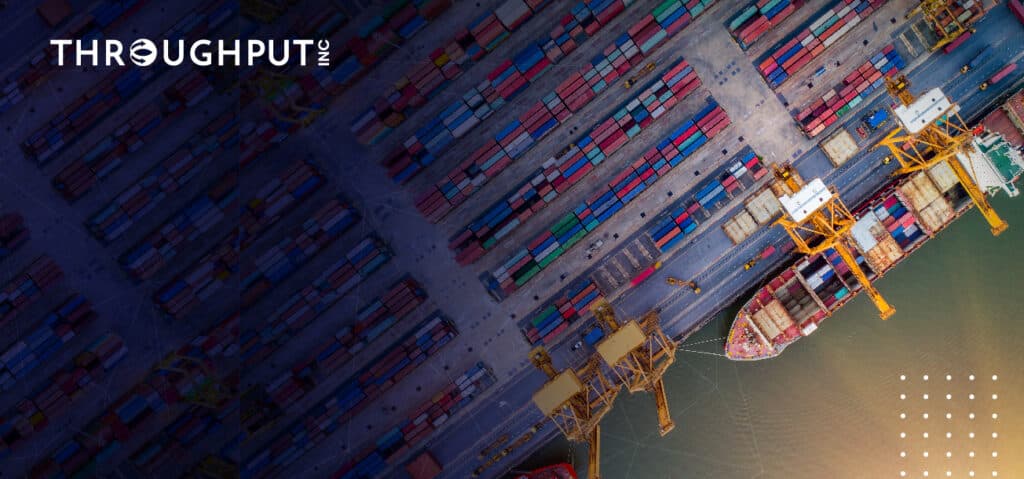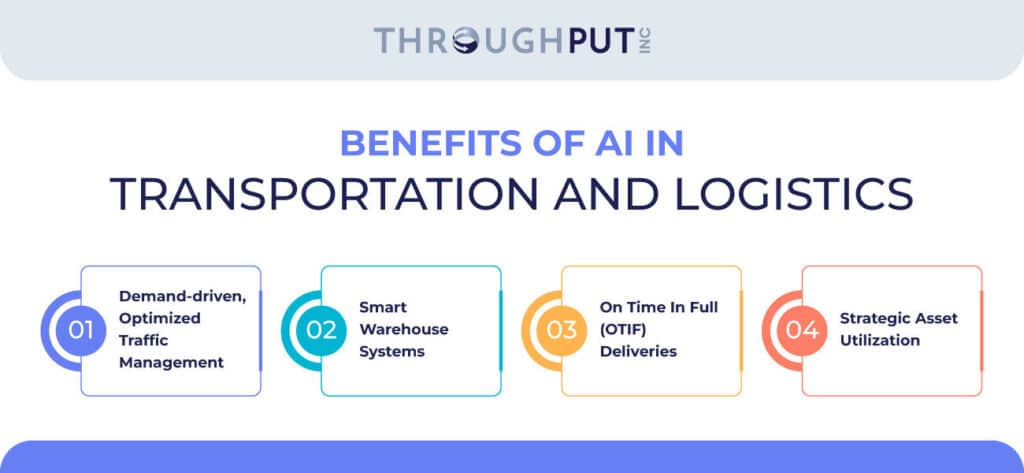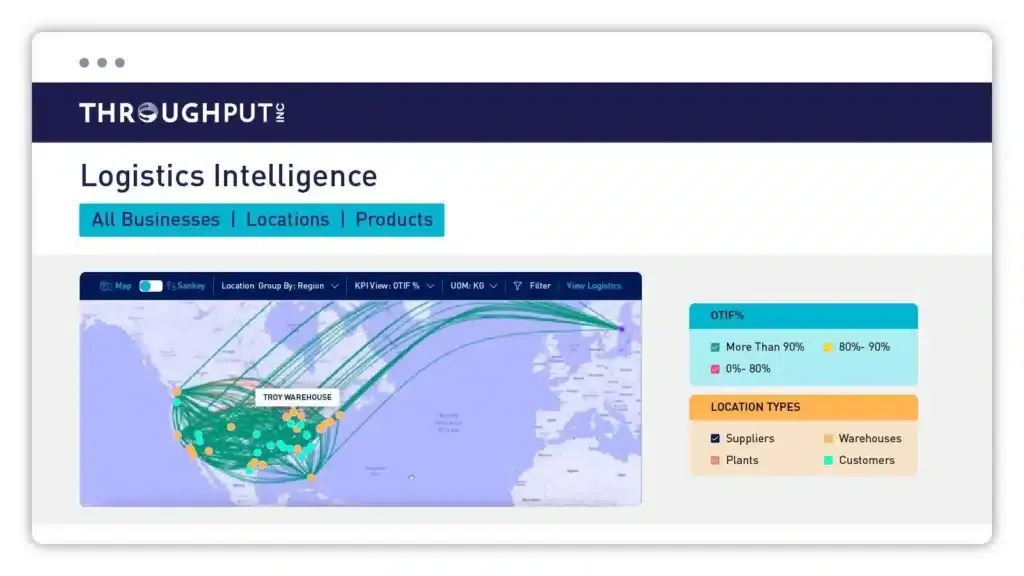AI in Transportation and Logistics: Steering Towards Smarter Operations

The transportation and logistics industry has witnessed a profound transformation over the past few years, driven by a mix of industry disruptions and emerging innovative technologies. Of these technologies, artificial intelligence (AI) in transportation and logistics has emerged as a game-changer, completely revolutionizing the way businesses manage and optimize their supply chains.
The ability of AI to process vast amounts of data, predict potential scenarios and outcomes, and recommend intelligent decisions has made it a critical tool in the logistics industry. But though AI has proven a wide range of diverse applications and benefits in logistics, many businesses still fail to leverage the true, full potential of AI in their distribution processes.
Role of AI in the Transportation and Logistics Industry
The adoption of AI in transportation and logistics industry has led to significant advancements in several operations, the most talked about of which has till date been warehouse automation. Robots have helped efficiently sort, pick, and pack inventory, considerably speeding up order fulfillment.
However, while this has dramatically improved efficiency in warehouse processes, it is only the tip of the iceberg when it comes to the potential applications of AI. In reality, AI in transportation and logistics can increase efficiency across supply and distribution processes, starting from real-time tracking and monitoring of inventory in warehouses (or on the move), to demand-driven optimization of inventory and distribution to minimize wastage and transportation costs.
This, in turn, creates considerable new data that can be fed back into the system to further improve process efficiency. Thus, AI can transform warehouses into high-tech, highly efficient distribution centers that can not only keep up with the rapidly growing demand in today’s consumer environment but also help improve the overall customer experience.
In other words, the need to integrate AI in transportation and logistics is no longer an opportunity but a necessity.
Benefits of AI in Transportation and Logistics
AI has revolutionized the way businesses move goods and material. Key benefits of AI in transportation and logistics include:

Demand-driven, Optimized Traffic Management
AI-powered traffic management systems help businesses eliminate congestion and bottlenecks, optimize transportation routes, schedules, traffic flow, and capacity allocation, and minimize travel times based on real-time demand changes. This, in turn, improves delivery times, optimizes fuel consumption, and reduces harmful emissions.

Smart Warehouse Systems
AI makes it possible to deploy smart warehouse systems that can rapidly adapt and respond to new scenarios and optimize operations across the entire logistics network. As a result of streamlined, optimized warehouse operations, overall productivity goes up substantially.
On Time in Full (OTIF) Deliveries
Logistics operations are key to supply chain operations, right from procurement to production and distribution. Optimizing logistics is thus critical to successful demand fulfillment. AI enables businesses to optimize movement of material to ensure OTIF order fulfillment at the least possible cost – leading to enhanced customer satisfaction and a much-needed competitive edge in the market.
Strategic Asset Utilization
In 2021, it cost more than $20,000 to ship a regular 40-foot container from China to the US east coast – compared to less than $3,000 only two years ago. In the face of such disruptions, it is essential for businesses to maximize the outcomes of their logistics processes and enhance the value derived from all of their logistics assets.
AI helps this by offering fully transparent visibility into fleet performance, allowing logistics executives to strategically utilize their assets as well as safeguard them against unanticipated risk.
AI also enables businesses to match capacity to demand – thus decreasing shipment of empty containers, and reducing the number of vehicles on the go. These vehicles can then be directed to locations where there is demand (or is predicted to go up), ensuring efficient asset utilization while significantly reducing operational costs.
In summary, AI in transportation and logistics holds the potential to accelerate efficiency, cost, and sustainability across the entire logistics network.
AI is Reshaping the Transportation and Logistics Industry
Taking a few steps back, the above benefits translate into game-changing business value in the long run. AI is essentially enabling logistics decision-makers – at large and small businesses alike – to evaluate “what if” alternatives against an increasingly complex and dynamic backdrop of opportunities, risks, and constraints.
It is also increasing the ability of businesses to be proactively responsive to frequent disruptions, while ensuring continued inventory and network optimization – a key requirement for business survival and growth.
Innovative business leaders are applying AI to their daily logistics operations in a variety of ways, and are racing ahead in their journey toward a future of a reimagined logistics landscape.
Top 3 Use Cases for AI in Transportation and Logistics
While AI adoption in the logistics and transportation space was slightly slower than in other segments, it has rapidly gained momentum over the past few years. It is now revolutionizing the way businesses manage production, warehouse and distribution centers, and customer demand while improving efficiency, reducing costs, and increasing profits.
Here are the top three high-impact AI use cases in logistics today.
Route Optimization and Freight Management
AI helps businesses analyze existing routes, evaluate the cost-benefit ratios for alternative routes, and optimize them for the best outcomes under varied business conditions. Route optimization leverages shortest-path algorithms to help identify the most efficient routes for rail, road, or sea freight – at scale, and in real time.
Thus, businesses can significantly speed up the shipping process while at the same time minimizing shipping costs. Importantly, route optimization is also an effective tool to minimize carbon emission and accelerate sustainable transportation.
Invoice Control
One of the key benefits of AI in transportation and logistics is automation of the invoice process, which enables invoice control. AI analyzes invoice data and automatically matches invoices to purchase orders and verifies all prices and quantities to detect any discrepancies in the procurement process. This significantly cuts down on the time and effort involved in processing invoices and ensuring timely payments, and accelerates the process of shipping material out at the right time.
Warehouse Slotting
Warehouse slotting has traditionally been regarded as a never-ending puzzle as it is a complex process that has to find the right delicate balance between inventory layout and efficiency. AI can analyze numerous warehouse configurations to identify the best layout for a given inventory at any point of time. It factors in historical data on product movement against a backdrop of current data such as turnover rate, demand trends, SKU velocity, marketing promotions, and shelf life and weather conditions to identify demand and product movement patterns.
These insights can in turn be leveraged to optimize product placement, increase pick density, and improve overall demand fulfillment by maximizing On Time In Full (OTIF) deliveries.
AI can also detect the correlation between products. For example, it can sense that when a keyboard is ordered, it is likely that a mouse may also be ordered. Detecting this correlation can help group items that are frequently ordered together, so that they can be placed in close proximity to each other in the warehouse.
Companies that are Leading the Deployment of AI in Transportation and Logistics
DHL
DHL has adopted AI to optimize its delivery routes and also to reduce fuel costs. The company leverages AI to analyze data such as delivery addresses, traffic patterns, and weather conditions to identify the most efficient delivery routes, resulting in lower fuel consumption and enhanced delivery times.
UPS
UPS leverages AI-powered predictive analytics to analyze data on customer demand, package volume, and delivery routes to predict and prevent delivery delays – and optimize its delivery network. This has resulted in vastly better delivery times at much lower costs for the company.
Maersk
The world’s largest shipping company Maersk leverages AI to optimize its shipping routes and fuel consumption. With an AI-powered routing system that factors in weather patterns, ocean currents, and other influencing factors, the company determines the most optimized route for each of its shipments.
Amazon
AI shows up in nearly all of Amazon’s processes, from months before a delivery begins right up to when a driver is assigned to the delivery of a package to a customer’s doorstep. The company famously deployed AI-powered robots in its warehouses to maximize efficiency and cut back labor costs. The robots move packages around the warehouse, pick and pack orders, and transport packages to the shipping area.
How ThroughPut AI is a Gamechanger for Logistics and Transportation
ThroughPut AI’s logistics planning module empowers logistics planners and managers to analyze routes, carriers, and load efficiencies for immediately actionable insights. It enables:
- Enhanced real-time visibility across transportation, warehouses, and inventory
- Demand-driven logistics planning to reduce costs and carbon emissions
- Connected warehouse management to optimize distribution and inventory levels
With ThroughPut, businesses benefit from:
A Single View of All Shipments
ThroughPut enables businesses to easily compare multiple shipments and period volumes and stagger overlapping shipment cycles to avoid congestion and delays. They can compare received, delivered, and sold aggregate volumes by route as well as shipment type to understand the impact of various order fulfillment options on margins.

SKU Optimization
This helps businesses implement end-to-end SKU analysis across multiple channels and review the impact of logistics performance on OTIF order fulfillment. Thus, they can ensure a holistic SKU flow all the way from supplier through to distribution networks and stores.
Improved OTIFs with Reduced Carbon Emissions
ThroughPut also enables businesses to eliminate siloed material flow views and instead visualize the flow of a particular SKU, or a cluster of selected SKUs, across the distribution network. Thus, they can accelerate shipping of the right goods at the right time, while minimizing runtime costs and risks. Using a combination of business rule mapping and ML-based pattern extractions, they can predict ETAs to drive a high rate of OTIFs.
To learn more about how ThroughPut can enable your logistics and transportation with AI, book a call with us today.
